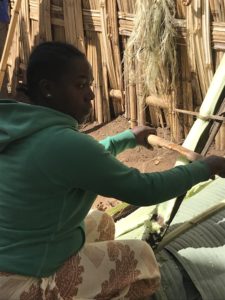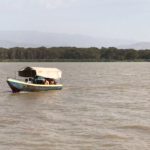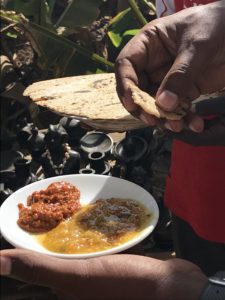28 January 2018
Sunrise reddens the sky above The Bridge of God, haze hangs over lakes Abaya and Chamo. It is a baboon-less morning at Paradise Lodge in Abra Minch.
 The nearby Arba Guge Mountains is home to several villages of the Dorze people. We climb into our 4x4s and slowly drive into mountains green with pine, eucalyptus, acacia, and a plethora of banana trees. These are dirt and gravel roads with the ever-present dust. The altitude reaches 8,000 ft., temperatures cool and a wonderful breeze stirs the trees. The Dorze have inhabited this small highland area for hundreds of years. It is a good choice of location, location, location.
The nearby Arba Guge Mountains is home to several villages of the Dorze people. We climb into our 4x4s and slowly drive into mountains green with pine, eucalyptus, acacia, and a plethora of banana trees. These are dirt and gravel roads with the ever-present dust. The altitude reaches 8,000 ft., temperatures cool and a wonderful breeze stirs the trees. The Dorze have inhabited this small highland area for hundreds of years. It is a good choice of location, location, location.
The first thing that catches my eye is the gigantic wake occurring on the hill above their village. Friends are honoring a village elder who died last night. This is not the first wake I have seen. Driving into town yesterday, hundreds were gathering to meet a coffin. The wailing, tears and demonstrations of grief were genuine. This morning, it appears the entire village has gathered to pay their respects. Services will occur in a week at the church.
 We visit this village to learn about the culture of the Dorze. There are about 8,000 in this area. Surrounded by an abundance of banana trees and bamboo, the Dorze make good use of these fast growing plants using the bamboo for everything from fencing to homes. With bamboo, the Dorze builds a beehive hut about 40 ft. in circumference and 20 ft. high. Ingenious little vents, windows and overhangs for doorways are built into the construction. I don’t know about the hut looking like an elephant, but it does look comfortable and utilitarian.
We visit this village to learn about the culture of the Dorze. There are about 8,000 in this area. Surrounded by an abundance of banana trees and bamboo, the Dorze make good use of these fast growing plants using the bamboo for everything from fencing to homes. With bamboo, the Dorze builds a beehive hut about 40 ft. in circumference and 20 ft. high. Ingenious little vents, windows and overhangs for doorways are built into the construction. I don’t know about the hut looking like an elephant, but it does look comfortable and utilitarian.
Because of the constant presence and voracious appetites of the local termites, which nibble away at the base of the hut, the Dorze build their huts tall. However, the termites will eventually destroy the bottom of the hut. As a consequence of damage, the Dorze will periodically move their hut, cut off the bottom damaged part, and burn the old location to kill the termites. As the hut gets shorter, the Dorze can unweave a section of the door overhang in order to make it taller. The roof can also easily be restored. Thus, a hut can last for decades.
A few lopsided examples were in need of a little “altitude adjustment.” Termites can whittle down these huts to under 9 feet at the peak. The height difference between the newest and oldest homes was appreciable. When the hut becomes too short, it will be used for cooking or storage. They will then build a new hut with the abundance of bamboo that grows nearby.
The Dorze are also quite proud that they now have electric lights in their homes. Entering one of the homes I find it quite spacious. There are two sleeping beds near the entrance and inside the hut are the cooking and storage areas. To the right, behind a low wall are two cows and two goats. The interior is smokey but the Dorze believe the smoke keeps them warm and retards the termites.
 We were given a very interesting demonstration on the preparation of their main foodstuff which comes from the false banana tree. This plant is larger than the traditional banana tree and drought resistant. The false banana is a prolific, long lived tree. From it, the Dorze uses the leaves for wrapping foods for carrying and cooking. The fibrous trunk can provide years of food staples. Part of its stem or trunk can be sliced off without harming the plant. From this piece of trunk, they can scrap away the fibrous interior and squeeze out its liquid, and from this liquid comes a sediment that can be dried to a powder. This powder is called bula. Bula is then used for making a nutritious, calcium rich porridge. It is also thought to be medicinal.
We were given a very interesting demonstration on the preparation of their main foodstuff which comes from the false banana tree. This plant is larger than the traditional banana tree and drought resistant. The false banana is a prolific, long lived tree. From it, the Dorze uses the leaves for wrapping foods for carrying and cooking. The fibrous trunk can provide years of food staples. Part of its stem or trunk can be sliced off without harming the plant. From this piece of trunk, they can scrap away the fibrous interior and squeeze out its liquid, and from this liquid comes a sediment that can be dried to a powder. This powder is called bula. Bula is then used for making a nutritious, calcium rich porridge. It is also thought to be medicinal.
The fibrous scrapings are called enset and are fermented over several months, sort of like sourdough, with the taking and adding to the pile over time. The woman will take a handful of the enset, which is very powdery, chop and refine the dough to reduce the incidence of fibers still in the paste, add a little water, flatten it out like a pizza crust, place it between two banana leaves, and roast this on an open fire. The result is a warm, delicious pita-type bread called kocho which is dipped in chili sauce or honey. The Dorze, like many Ethiopian’s, love chilies and the sauces are indeed hot.
And of course, there always seems to be a local drink, what I refer to as “rotgut.” The village’s sorghum drink is about 40% alcohol and strong enough to kill all those termites should villagers choose to sprinkle some around the base of their huts. We were not offered any.
The Dorze are also well known for their weaving of cotton products such as elaborate scarves and blankets. Wise to western tourist trade, items are priced accordingly. The children, as voracious of sellers as any human would encounter, attempt to surround and hound for a sale. Necklaces, scarves, pottery (don’t know where made) and beaded necklaces are shoved into your face. Prices are certainly negotiable and reasonable if one has a use for these things.
After lunch, we drive to Nech Sar National Park to board a boat for a relaxing ride on Lake Chamo. On the way, we pass a dumping area and witness a large group of prehistoric-looking marabou acting like the scavengers they are. There is a brisk breeze on the lake, which is the traditional brown color caused by the abundance of volcanic silt. Here, I am supposed to be able to photograph shy hippos, basking crocodiles and abundant bird life.

Lake Chamo
We motored some distance across the lake, spotting several noble fisher eagles in the trees. They are easy to spot because of their similar coloring to the American Bald Eagle. We finally spot our first Nile Crocodile, responsible for the deaths of eight fishermen last year. These are aggressive crocks and the largest I have ever seen. Two laying on the shore looked to be 16-18 feet long and certainly big enough to take a man or cow.
The hippos were scarce though we did see a few in the water. The lake is up to 40 ft. deep, yet the hippos are far from shore and enjoying its depths. Not much to see but twitching ears and two bubble eyes poking above the brown water. One did show off and did a bit of diving, showing us her back as she gracefully rolled into the water.
Upon returning to the dock, we are treated to a wedding in full celebration. Singing, chanting and jubilant bouncing and dancing, the celebrants are quite a contrast to the wake earlier this day. And this gathering of hundreds is just for the photos. The dinner will be at the groom’s house. We pass bus loads of people, tuk tuks and motorbikes decorated with streamers and balloons heading to the festivities.
It is going to be quite a night.

0 Comments